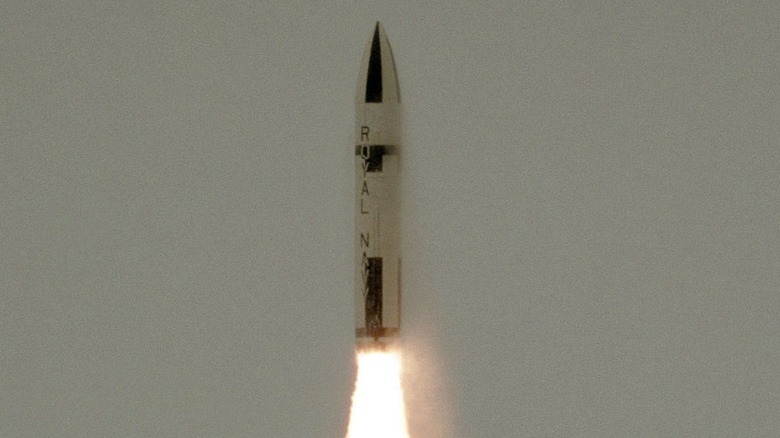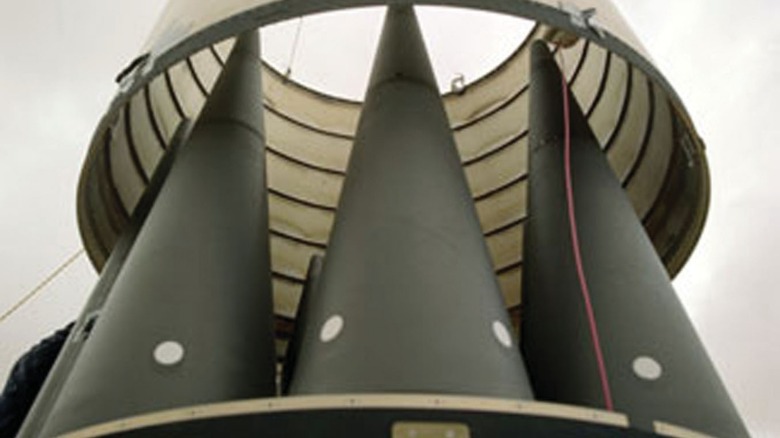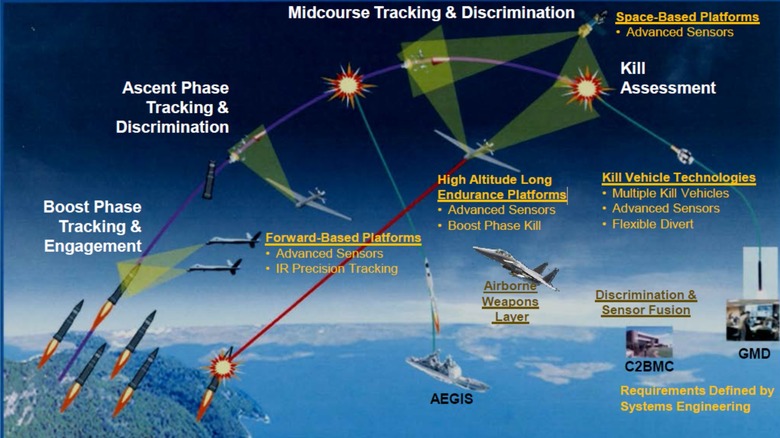How Much Damage Can A Ballistic Missile Do And Can It Be Stopped?
There are many types of missiles that have been developed over the years, and technically, they are all ballistic. Ballistics deals with how an object moves through the air, and there are three areas: internal, external, and terminal ballistics. To simplify things, and because most people think of Intercontinental Ballistic Missiles (ICBM) when they hear the term "ballistic missile," that's what will be covered in this article. There are many types of ICBMs, and they've all been developed for one purpose: to deliver nuclear warheads.
Depending on the type of ICBM, there are numerous options for the amount of decoys, warheads, and other components that go into their makeup. Once an ICBM is fired, there's not a lot a target nation can do to shoot one down, as it's not technologically possible in many instances as of 2025. Despite this, there are many efforts underway to create ICBM defense shields. Israel uses a variety of anti-missile defense systems to shoot down short and medium-range missiles, and the U.S. has its own as well.
When trying to determine the amount of damage a single missile can bring, it's important to delve into their warheads' explosive yield. A kiloton is a unit of explosive power equivalent to 1,000 tons of TNT, while a megaton is equivalent to 1,000,000 tons of TNT. The U.S.' modern nuclear weapons are in the high kiloton range, so looking back at the bombings of Hiroshima and Nagasaki, Japan offers clues to a modern atomic or nuclear bomb and its destructive power when delivered via a ballistic missile.
The damage a ballistic missile deals can be massive
The United States uses the LGM-30 Minuteman III ICBM as one of the key elements of the nation's nuclear triad. There are other types of missiles capable of carrying nukes, but the Minuteman is the current ICBM of choice. It carries a single W87 warhead, which has a destructive blast yield of between 300 and 475 kilotons. Before the START II treaty, the ICBM carried three warheads, and future plans for the LGM-35 Sentinel, which will replace the Minuteman III, will likely carry more than one. Looking at the W87's highest yield, it can cause a massive amount of destruction.
The Hiroshima and Nagasaki bombs, which weren't carried by missiles but were dropped, had an explosive yield of 15 and 21 kilotons, respectively. Those bombs killed over 214,000 people and destroyed the two cities, sparing few buildings and lives. That places a single W87-1 warhead at more than 22 times the destructive power of the largest nuclear bomb ever used in war. The website Nuclear Secrecy maintains a tool called Nukemap, which calculates a radius of destruction based on location and explosive yield.
According to Nukemap, if a W87-1 was dropped on the city today, Hiroshima, Hatsukaichi, Saka, Kumano, Kaita, and Fuchu would also be destroyed or heavily damaged. Conversely, if the same bomb fell on Washington, D.C., it would destroy the capital, Alexandria, Bethesda, College Park, Hyattsville, and about a dozen other small cities that make up the Washington, D.C., greater metropolitan area. Much of the urbanized locations would be destroyed or significantly damaged, and depending on how the bomb was detonated, nuclear fallout is a significant risk.
Shooting one down is like hitting a bullet with a much smaller bullet thousands of miles away
ICBMs represent a real and existential threat to any society, which is why President Donald Trump indicated an interest in constructing a so-called "Golden Dome" to shield the United States from potential harm. The country already has a missile defense system made up of multiple launch systems and interceptors, but it's not up to the challenge posed by an ICBM. Because of the way they travel to their targets, the ability to launch decoys, and the speed at which their warheads travel to their targets, it's incredibly hard to shoot down an ICBM.
Despite the technical limitations afforded by modern technology, shooting down an ICBM is unlikely, but it's also not impossible. An ICBM can be shot down during two of its three phases, which are Boost (2-5 minutes), Midcourse (20-30 minutes), and Terminal (Less than one minute). While it's possible to shoot down an ICBM soon after it launches during its Boost phase, it's unlikely, as it would probably be fired far from any interceptors capable of striking it. That leaves the Midcourse phase as the one to shoot for, pun intended.
Unfortunately, striking an ICBM during its Midcourse phase means the interceptor first has to fly at least 3,100 miles high just to match altitude. It then has to find the ICBM, some of which can travel up to Mach 23 (17,647 mph). Once that's achieved, the interceptor would have to somehow differentiate between legitimate target warheads, the missile, and its decoys, which makes the whole prospect a technical nightmare that requires a great deal of additional improvement and testing to become reliable.


